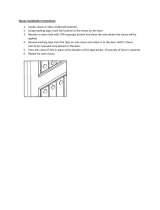
18 - FR
(fig. D)
Ne jamais utiliser
de gaz combustibles ou tout autre type de gaz réactif
comme source d’énergie pour cet outil. Leur utilisation
représente un danger d’explosion et peut se solder par
des blessures corporelles graves. (fig. E)
(fig. F)
Un déclenchement
intempestif pourrait se produire lors du réglage du
déclencheur si l’outil est raccordé à la source d’alimentation
en air en présence de clous dans le chargeur. (fig. G)
•
Ne pas charger les attaches alors que la gâchette
est enfoncée ou que le déclencheur de contact est activé
pour éviter un enfoncement accidentel.
Ne pas retirer le
ressort du déclencheur. Inspecter quotidiennement le bon
fonctionnement de la détente et du déclencheur. Une
décharge non contrôlée pourrait survenir.
•
Les




















